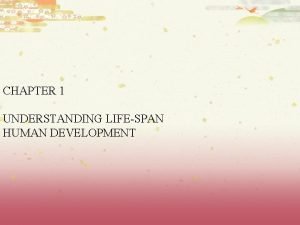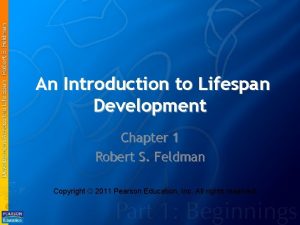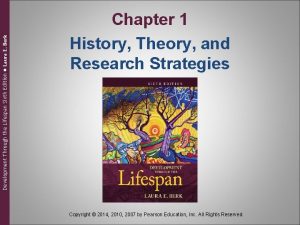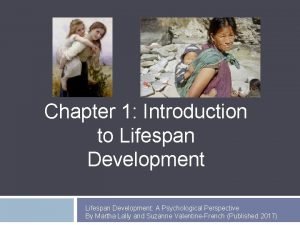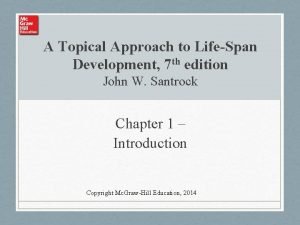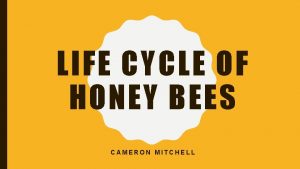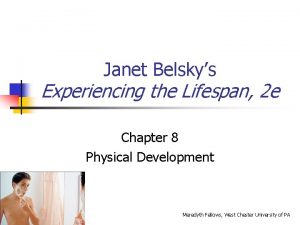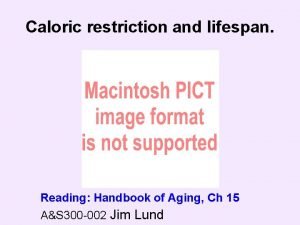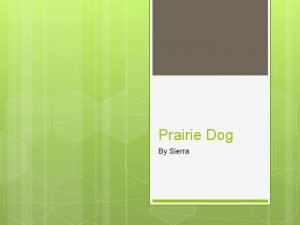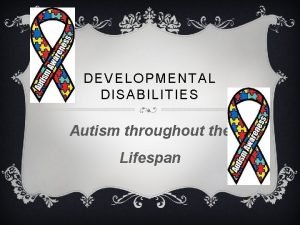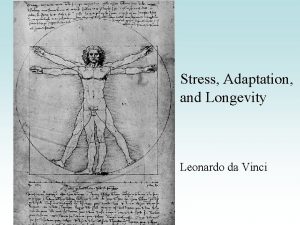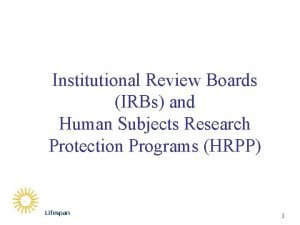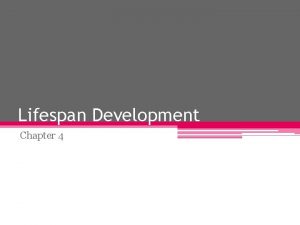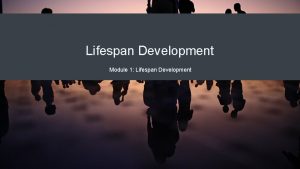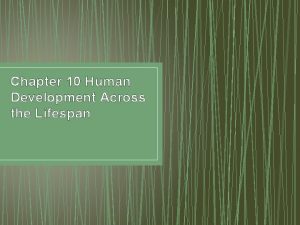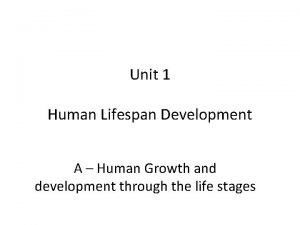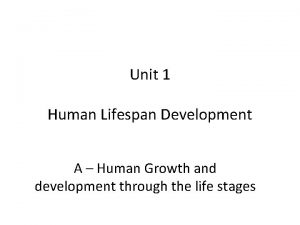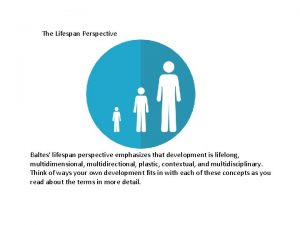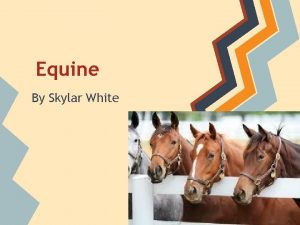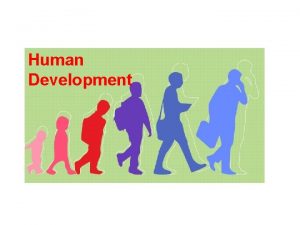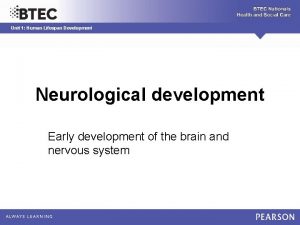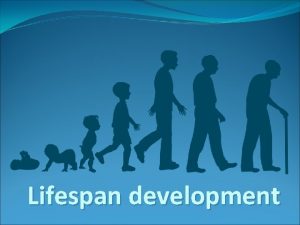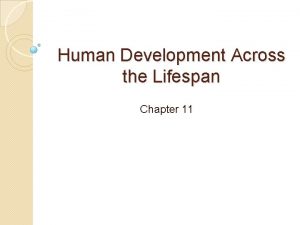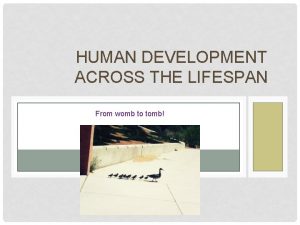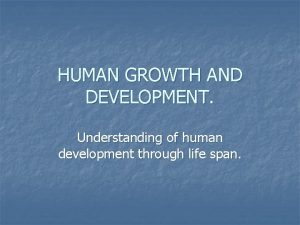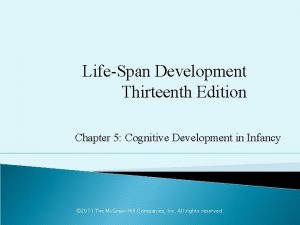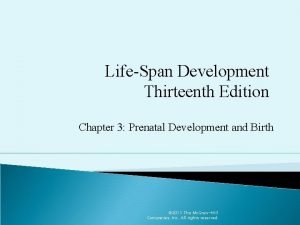CHAPTER 1 UNDERSTANDING LIFESPAN HUMAN DEVELOPMENT What is




![[Insert Table: SR 6 e. tab. 1. 1. jpg] [Insert Caption] [Insert Table: SR 6 e. tab. 1. 1. jpg] [Insert Caption]](https://slidetodoc.com/presentation_image/475deef9867fb45dffeb0c9cb3169030/image-5.jpg)
























- Slides: 29

CHAPTER 1 UNDERSTANDING LIFE-SPAN HUMAN DEVELOPMENT

What is Development? u. Systematic changes and continuities v. In the individual v. Between conception and death w “Womb to Tomb” u. Three broad domains v. Physical, Cognitive, Psychosocial

Other Developmental Definitions u Growth: Physical changes that occur from birth to maturity u Aging: Positive and negative changes in the mature organism u Maturation: The biological unfolding of the individual genetic plan u Learning: Relatively permanent changes due to environmental experiences

Age Grades, Age Norms, and the Social Clock u. Age Grade: Socially defined age groups v. Statuses, roles, privileges, responsibilities v. Adults can vote, children can’t u. Age Norms: Behavioral expectations by age v. Children attend school u. Social Clock: When things should be done v. Early adulthood – time for 1 st marriages u“Off time” experiences are more difficult
![Insert Table SR 6 e tab 1 1 jpg Insert Caption [Insert Table: SR 6 e. tab. 1. 1. jpg] [Insert Caption]](https://slidetodoc.com/presentation_image/475deef9867fb45dffeb0c9cb3169030/image-5.jpg)
[Insert Table: SR 6 e. tab. 1. 1. jpg] [Insert Caption]

Phases of the Life Span u. Before 1600: Children viewed as miniature adults


u. Modern View: Children innocent, need protection

u. Average life expectancy in 1900 was 47 year u. In 2000 it was 77. 5 years v. Females: White=80, Black=76 v. Males: White=75, Black=69 u. Increasing population - age 65 and older

The Demographics of Aging Population Trends in the United States

The Demographics of Aging Population Trends in the United States

The Demographics of Aging Population Trends in the United States

The Demographics of Aging Population Trends in the United States

Diversity of Older Adults in the U. S.

Population Trends Around the World

Population Trends Around the World

Framing the Nature/Nurture Issue u. Nature: heredity v. Maturational processes guided by genes v. Biologically based predispositions v. Biological unfolding of genes u. Nurture: environment v. Learning: experiences cause changes is thoughts, feelings, and behaviors u. Interactionist view: nature & nurture interact

The Bioecological Model u. Microsystem: Immediate environment u. Mesosystem: Relationships u. Exosystem: Social Systems u. Macrosystem Culture u. Chronosystem: Changes occur in a time frame u. This is an interactionist model

u Urie Bronfenbrenner

Goals of Studying Life. Span Development u. Description v. Normal development, individual differences u. Explanation v. Typical and individually different development u. Optimization v. Positive development, enhancing human capacities v. Prevention and overcoming difficulties

Methods of Studying Life -Span Development u Historical v. Baby Biographies: Charles Darwin v. Questionnaires: G. Stanley Hall u Key Assumptions of Modern Life-Span Perspectives v. Lifelong, multidirectional process v. Gain and loss and lifelong plasticity v. Historical/cultural contexts, multiple influences v. Multi-disciplinary studies

Unique Challenges in Developmental Research u. Infants and young children v. Attention, instruction, answering questions may be difficult u. Elderly Adults v. Possible sensory impairments v. Discomfort being studied, tested

Conducting Developmental Research u. Self-reports: interview, questionnaires, tests u. Behavioral Observations (Experiments) v. Naturalistic w Advantage: natural setting w Disadvantage: conditions not controlled v. Structured (Lab) w Disadvantage: cannot generalize to natural settings w Advantage: conditions controlled

The Scientific (Experimental) Method u. Three Critical Features v 1. Manipulation of independent variable v 2. Random assignment of individuals to treatment conditions v 3. Experimental control

u. The scientific method in action

The Correlational Method u. Determine if 2 or more variables are related u. Correlation: A measure of the relationship v. Can range from +1. 0 to – 1. 0 v. Positive: variables move in same direction v. Negative: variables move in opposite dir. u. No relationship if correlation is 0 u. Cannot establish a causal relationship

Developmental Research Designs u. Cross-Sectional Designs v>1 cohorts or age-groups studied v 1 time of testing v. Studying age differences at any one time u. Longitudinal Designs v <1 cohort v+1 time of testing v. Study changes across time in one cohort

u Cross-sectional and longitudinal studies of development from age 30 to age 70.

Age, Cohort, and Time of Measurement Effects u. Age effects: Changes which occur due to age u. Cohort Effects: Born in one historical context v. Changes due to differences in society v. Disadvantage of cross-sectional design u. Time of measurement effects: Historical v. Take place at time of data collection v. Disadvantage of longitudinal design
 Chapter 9 lifespan development
Chapter 9 lifespan development Development takes place gradually
Development takes place gradually Exploring lifespan development chapter 1
Exploring lifespan development chapter 1 Exploring lifespan development chapter 1
Exploring lifespan development chapter 1 Development through the lifespan 6th edition
Development through the lifespan 6th edition Discontinuous development psychology
Discontinuous development psychology A topical approach to lifespan development
A topical approach to lifespan development Ul guidance counselling
Ul guidance counselling Lifespan development third edition
Lifespan development third edition Lifespan development third edition
Lifespan development third edition Human needs and human development chapter 8
Human needs and human development chapter 8 Chapter 8 human needs and human development
Chapter 8 human needs and human development Adler and rodman 2006
Adler and rodman 2006 Human development index definition ap human geography
Human development index definition ap human geography Snow leopard lifecycle
Snow leopard lifecycle Pelican eels
Pelican eels Display marzipan petit fours
Display marzipan petit fours Splendour beetle
Splendour beetle Honeybee lifecycle
Honeybee lifecycle Juan ponce de leon nationality
Juan ponce de leon nationality Janet belsky
Janet belsky Henry hudson lifespan
Henry hudson lifespan Lifespan of every animal
Lifespan of every animal The developing person through the lifespan
The developing person through the lifespan Characteristics of a prairie dog
Characteristics of a prairie dog Autism lifespan
Autism lifespan Nutrition across the lifespan
Nutrition across the lifespan Longest lifespan
Longest lifespan Da vinci lifespan
Da vinci lifespan Lifespan irb
Lifespan irb


